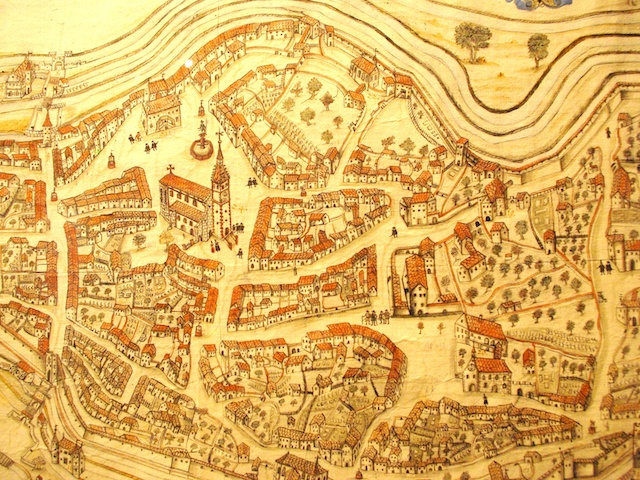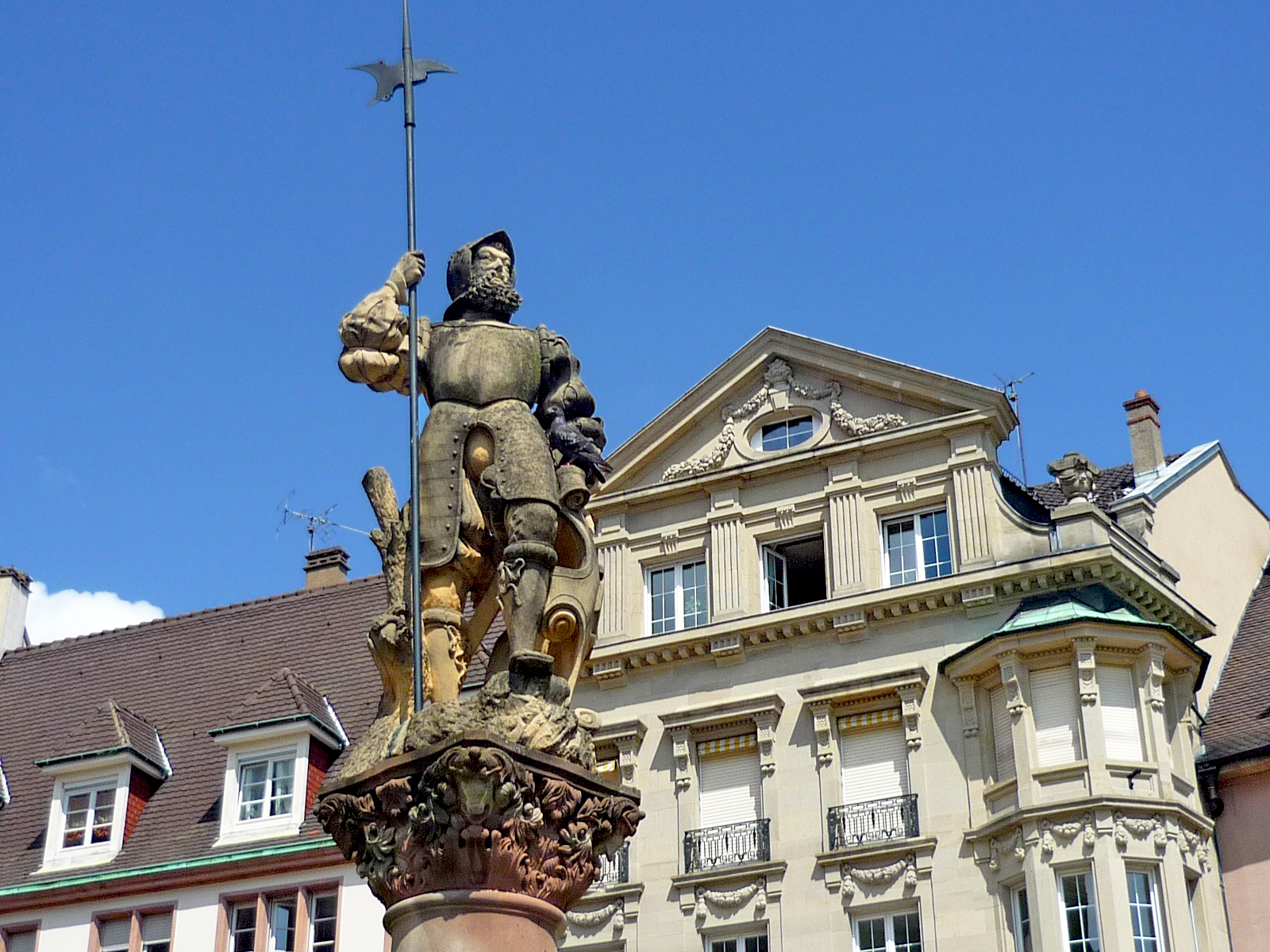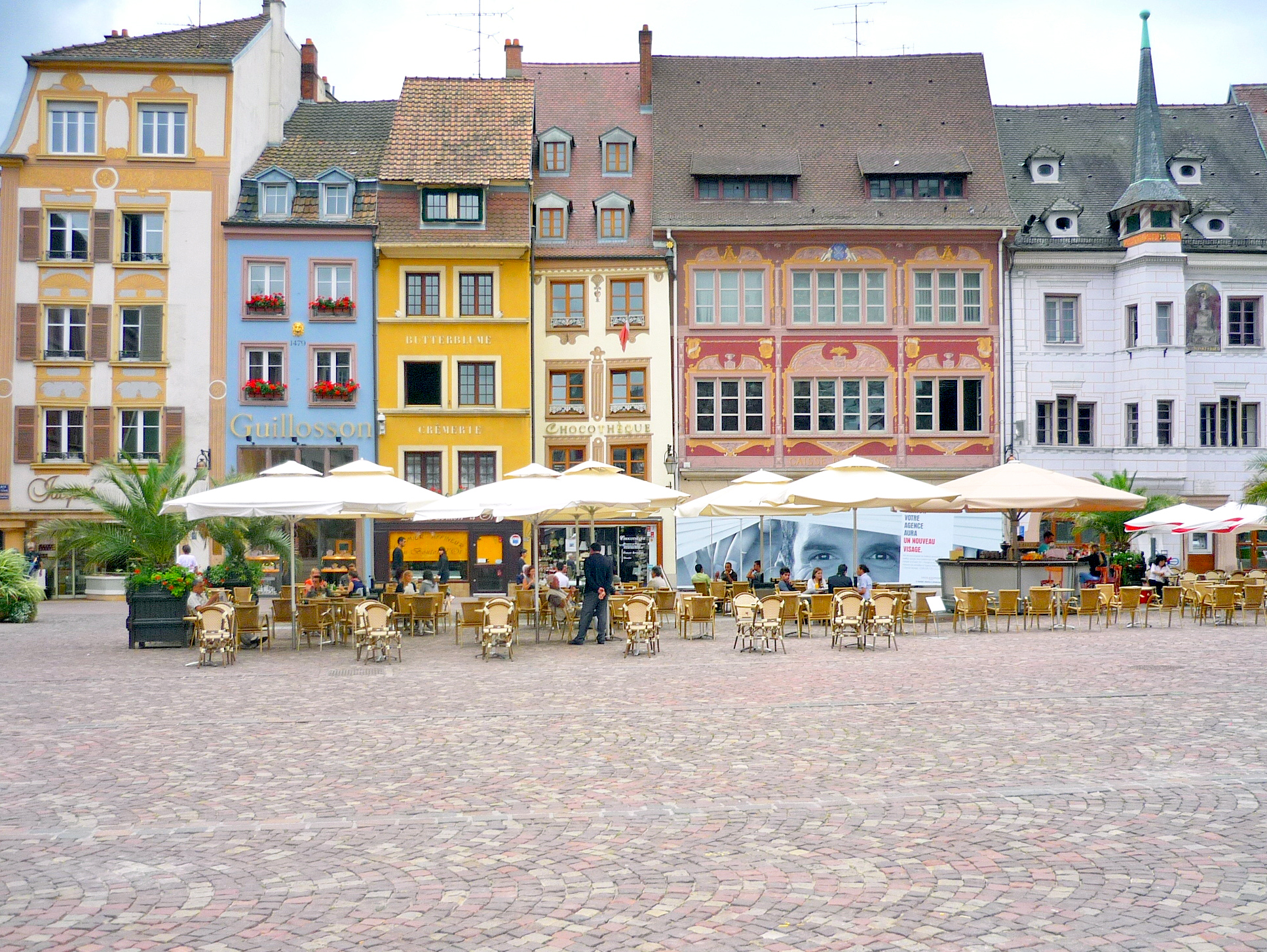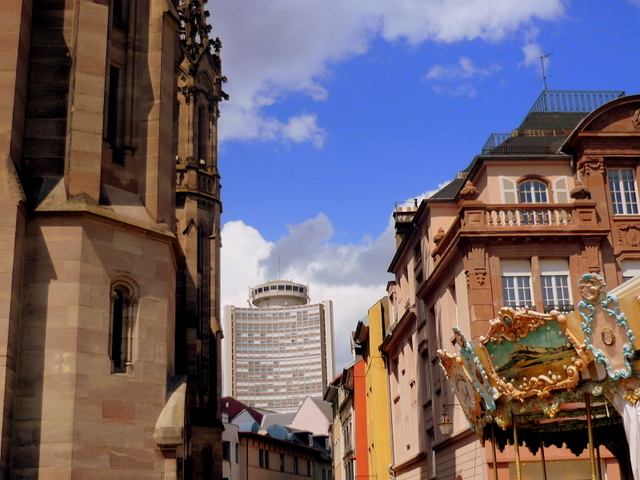Mulhouse history is about revealing a former Free Imperial City associated to Switzerland with a tradition of industrial activity taking root into the Rhineland in the 18th century.
The legend of the miller’s daughter
Legend has it that Mulhouse originated when the army of Attila the Hun was ravaging the region in 451 AD. A young wounded warrior attempted to flee the fighting and found refuge near a mill house. The daughter of the miller saw him and took care of him. Later, the warrior married her and they were joined by other wandering soldiers who married other maidens of the region. They set up their homes around the mill house and founded ‘Mulhouse’. This legend explains why the city’s coat of arms features a watermill wheel.
Mulhouse in the Middle Ages

More accurately, the first mention of the town of Mulhouse dates back to the 9th century. The first houses were built around a watermill which gives the town its name: Mülhausen (“Mill House”), whose wheel is still featured in Mulhouse’s coat of arms today.
During the reign of Frederick I Barbarossa in the 12th century, the little town grew up around Saint-Etienne square.
A century later, in 1308, the bourgeoisie freed themselves from the authority of the bishop of Strasbourg and Mulhouse acquired the title of Free Imperial City. A council of 12 members governed the town, comprising four people from nobility and eight patricians.
In the 14th century, the local craftsmen rebelled and expelled their leaders who had been conspiring with the Habsburgs. Mulhouse then became a bourgeois Republic. In order to preserve its autonomy and its trade, the town joined the alliance formed by 10 Free Imperial Cities in Alsace: the Decapolis.

Threatened by the Alsatian nobility and the influential Habsburgs whose territories encircled Mulhouse, in 1466 the town became closer to the Swiss cantons of Bern and Solothurn. In 1515, Mulhouse left the Decapolis and formed an alliance with the Swiss cantons. Its status of Free Imperial City combined with its Swiss alliance guaranteed its independence and allowed its inhabitants to be spared by the wars that devastated the Rhineland.
Between the Renaissance and the unification with France
In 1529, Mulhouse, influenced by the ideas of Zwingli, joined the Reformation whilst the South of Alsace, under the authority of the Habsburgs, remained Catholic.
Its neutrality during the Thirty Years War (1618-1648), which led to the annexation of Alsace to France, secured its prosperity and autonomy.
In 1746, Mulhouse and its 4,000 inhabitants saw the opening of the first manufacturer of textile printing in town by four local young men: Samuel Kœchlin, Jean-Jacques Schmalzer, Jean-Henri Dollfus and Jean-Jacques Feer. Several decades later, André Kœchlin was to found AKC (André Kœchlin & Compagnie), the ancestor of Alstom.
By the end of the 18th century, no less than 15 textile factories operated in Mulhouse, marking the beginning of the industrial development which fully bloomed during the 19th century in the textile, chemistry and engineering sectors.
A landlocked autonomous city surrounded by France, Mulhouse was encircled by a customs ban from 1792. Economically paralysed, the little Republic negotiated its unification with the young Republic of France which took place on the 15th March 1798. Mulhouse became the latest territory in Alsace to become French, 150 years after the Sundgau.

The unification with France went hand in hand with a period of formidable economic development. From 6,000 inhabitants in 1792, the population reached 30,000 in 1850 and 60,000 in 1866. The city expanded outside the medieval ramparts and new districts appeared at its periphery.
Mulhouse during the 19th Century: the French Manchester
Local industry benefited from the construction of the Rhin-Rhône canal and the first railway lines from Strasbourg to Lyon and Basle to Paris. Its influence reached the Upper Alsace up to the remote valleys of the Vosges. Mulhouse quickly became one of France’s most prosperous industrial towns, nicknamed the “One Hundred Chimneys City” or “French Manchester” (le Manchester français).
Industrialists, mostly Protestant, became so rich and influential that they began to monopolise political power. In 1826, the Société Industrielle de Mulhouse (SIM) was founded by Protestant industrialists such as Émile Dollfus and Joseph Kœchlin-Schlumberger. Acting as a kind of laboratory of economic, technical and social initiatives, the association is still active today and based on Place de la Bourse.
Refusing to ignore the miserable condition of the workers, the Mulhouse manufacturers came out with some ideas to make things better. They commissioned a veritable workers’ housing development plan that served as a model for garden-cities in Europe. In 1852, two prototypes of workers’ houses were built by architect Émile Muller. Over a thousand of these houses were built in the following years where each family had its private door and garden.
Mulhouse had enduring links with Louisiana, from which it imported cotton, and also with the Levant (Palestine, Lebanon and Turkey).
In 1848, the name of Mulhouse, the French version of Mülhausen was officially adopted.
In 1859 Alfred Dreyfus. who would later be wrongly accused of treason and condemned to deportation to French Guiana for perpetuity, was born in Mulhouse. The French Army Officer’s case divided France and led the French writer Émile Zola to publish the famous article “J’Accuse…!” in 1898.
Mulhouse during the Wars: 1871-1945
In 1871, Mulhouse became German by the Treaty of Frankfurt. Many industrialists from Mulhouse opted to keep their French nationalities, thus compelling them to immigrate outside Alsace. Many chose to move to Belfort, Nancy or Paris, contributing to growth and influence in the region. The wealthy expats brought capital which was used to create new companies. A famous example is that of the SACM (Société Alsacienne de Constructions Mécaniques) which was based in Mulhouse before moving to Belfort in the 1870s. Today, the SACM is known as “Alstom”, famous for its TGV trains, the fastest in the world.
Mulhouse had to adapt to the new German regime in place and it took the Alsatian city several years to do so before it became French once again in 1918.
The people of Mulhouse lived under Nazi occupation from 18 June 1940 to 21 November 1944. The Allied bombings at the time of the Liberation caused considerable damage to the town centre, which was mostly rebuilt using concrete. This period of reconstruction coincided with an influx of people who had come to Mulhouse and its region in search of work. More than 13,000 houses and apartments were built between 1950 and 1970 in the town centre (Place de l’Europe) as well as in the suburbs (Dornach).
Mulhouse Today

Today, Mulhouse is a thriving city strategically situated at the crossroads of two axes: Rhin-Rhône and Paris-Zurich. The proximity with Basle in Switzerland (27 km) and Freiburg-im-Breisgau in Germany (60 km) has been used as a major impetus to consolidate the cross-border co-operation of which the Euroairport is the best example.
The twin towns of Mulhouse are Antwerp, Belgium (1956), Walsall, UK (1962), Kassel, Germany (1965), Bergamo, Italy (1989), Chemnitz, Germany (1990), Timisoara, Romania (1991), Givatayim, Israel (1991) and Sofara, Mali (2003).




Dear Sir,
Thank you for this wonderful history. I wonder, can you tell me whether or not there was a mayor of Mulhouse in the early 1800’s whose surname was Rich? My great-great grandmother, born in 1831, was Catherine Rich, who married a man named Joseph Libis, born in France, Catherine was supposedly born in the area of Mulhouse, and came to the United States in 1854 with her husband. Family legend says that Catherine’s father was once the mayor of Mulhouse. I am trying to either verify or disprove this bit of information.
I hope to visit your country one day, and try to find some history myself. Thank you very much.
Thank you Virginia! I’ll respond directly to your email address! 🙂